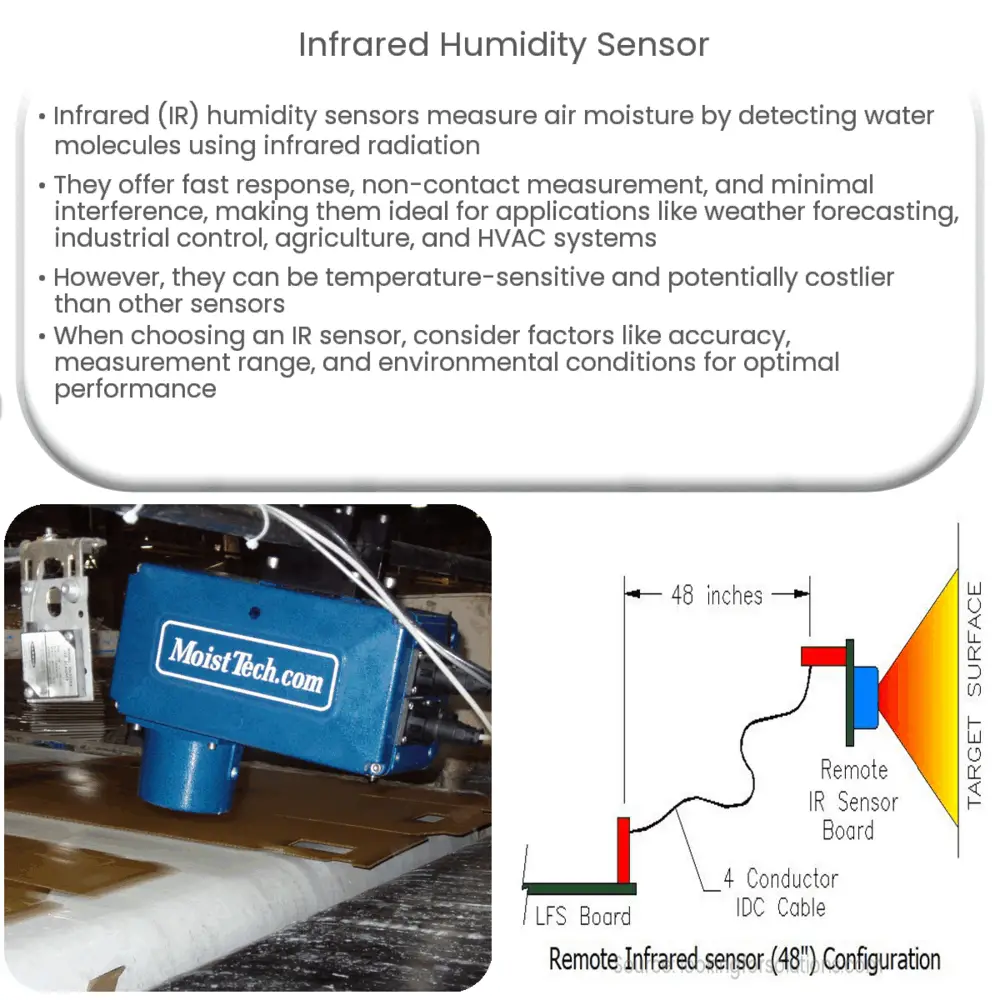An infrared humidity sensor measures air moisture by detecting water molecules’ absorption of infrared radiation, offering fast, non-contact, and accurate readings.

Infrared Humidity Sensor: An Overview
Introduction to Infrared Humidity Sensors
Infrared (IR) humidity sensors are devices that measure the moisture content in the air by detecting the presence of water molecules. These sensors are widely used in various applications, including weather monitoring, industrial process control, agriculture, and HVAC systems. In this article, we will discuss the working principle of infrared humidity sensors, their advantages and disadvantages, and some common applications.
How Infrared Humidity Sensors Work
Infrared humidity sensors operate based on the absorption of infrared radiation by water molecules present in the air. The basic principle is that water molecules have unique absorption characteristics within the infrared spectrum, which can be detected and measured by the sensor. An infrared light source, typically an LED or laser, emits a beam of infrared radiation at a specific wavelength that is absorbed by the water molecules in the air. The sensor then measures the amount of radiation that is absorbed, which is directly proportional to the humidity level.
There are two main types of infrared humidity sensors: reflective and transmissive. Reflective sensors measure the amount of infrared radiation that is reflected back to the sensor by the water molecules, while transmissive sensors measure the amount of infrared radiation that passes through the air and reaches the sensor on the other side. Both types of sensors can provide accurate measurements of humidity levels, but they have different advantages and disadvantages depending on the application.
Advantages and Disadvantages of Infrared Humidity Sensors
There are several advantages to using infrared humidity sensors for measuring moisture levels in the air. Some of these benefits include:
- Fast response time: Infrared sensors can provide near-instantaneous measurements of humidity levels, making them suitable for applications that require real-time monitoring and control.
- Non-contact measurement: Since infrared sensors do not require contact with the air being measured, they can be used in situations where other types of sensors may become contaminated or damaged by the environment.
- Minimal interference: Infrared sensors are less susceptible to interference from other gases or particles in the air, resulting in more accurate and reliable measurements.
Despite their advantages, infrared humidity sensors also have some drawbacks. These include:
- Temperature sensitivity: Infrared sensors can be affected by temperature changes, which may lead to inaccurate measurements if not properly compensated for.
- Cost: Infrared sensors can be more expensive than other types of humidity sensors, such as capacitive or resistive sensors, which may make them less suitable for certain applications.
Common Applications of Infrared Humidity Sensors
Infrared humidity sensors are used in a wide range of applications, including:
- Weather monitoring: Infrared sensors are often used in weather stations to measure humidity levels and provide accurate data for weather forecasting.
- Industrial process control: Infrared sensors can help monitor and maintain optimal humidity levels in manufacturing processes, ensuring product quality and preventing damage to equipment.
- Agriculture: Infrared sensors are used in greenhouse and agricultural applications to monitor humidity levels and optimize growing conditions for plants.
- HVAC systems: Infrared sensors can be used in heating, ventilation, and air conditioning systems to maintain comfortable indoor humidity levels and improve energy efficiency
.
Choosing the Right Infrared Humidity Sensor
When selecting an infrared humidity sensor for a specific application, several factors should be considered to ensure optimal performance and accuracy. These factors include:
- Measurement range: Choose a sensor with a suitable measurement range for the expected humidity levels in the application.
- Accuracy: Select a sensor with an accuracy level that meets the requirements of the application. Higher accuracy sensors may be more expensive, but they can provide more reliable measurements.
- Response time: Consider the response time of the sensor, especially if real-time monitoring is essential for the application.
- Temperature compensation: If the sensor will be used in an environment with significant temperature fluctuations, choose a sensor with built-in temperature compensation to ensure accurate measurements.
- Environmental considerations: Ensure that the sensor is suitable for the operating conditions, such as exposure to dust, chemicals, or extreme temperatures.
Conclusion
Infrared humidity sensors offer a reliable and accurate method for measuring moisture content in the air. With their fast response time, non-contact measurement, and minimal interference, they are well-suited for various applications, including weather monitoring, industrial process control, agriculture, and HVAC systems. However, it is essential to consider factors such as measurement range, accuracy, response time, temperature compensation, and environmental conditions when selecting the right infrared humidity sensor for a specific application. By doing so, users can ensure optimal performance and accurate humidity measurements for their needs.

